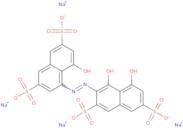Product Information
- 2,7-Naphthalenedisulfonic acid, 4,5,5′-trihydroxy-3,4′-azodi-, tetrasodium salt
- 2,7-Naphthalenedisulfonic acid, 4,5-dihydroxy-3-((8-hydroxy-3,6-disulfo-1-naphthalenyl)azo)-, tetrasodium salt
- 2,7-Naphthalenedisulfonic acid, 4,5-dihydroxy-3-(2-(8-hydroxy-3,6-disulfo-1-naphthalenyl)diazenyl)-, sodium salt (1:4)
- Tetrasodium 4,5-dihydroxy-3-((8-hydroxy-3,6-disulphonato-1-naphthyl)azo)naphthalene-2,7-disulphonate
- tetrasodium 4,5-dihydroxy-3-[(E)-(8-hydroxy-3,6-disulfonatonaphthalen-1-yl)diazenyl]naphthalene-2,7-disulfonate
- tetrasodium 4-hydroxy-5-[(2E)-2-(8-hydroxy-1-oxo-3,6-disulfonatonaphthalen-2(1H)-ylidene)hydrazinyl]naphthalene-2,7-disulfonate
Beryllon II is a fluorescent probe that is used in microscopy to detect cytotoxic effects. It has been shown to have a linear response in the presence of cytostatic drugs. The fluorescence intensity increases as the concentration of beryllium ions (Be) increases. This probe has also been shown to be linear over a wide range of concentrations and can be used with a simple optical sensor. Beryllon II is very selective for Be ions and does not react with other metal ions, such as magnesium or hydrochloric acid.





